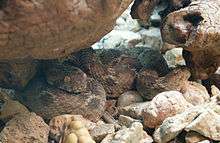Echis pyramidum
Echis pyramidum is a species of venomous viper endemic to Northeast Africa and the Arabian Peninsula. Three subspecies are currently recognized, including the nominate subspecies described here.[5]
| Echis pyramidum | |
|---|---|
 | |
| Scientific classification | |
| Kingdom: | Animalia |
| Phylum: | Chordata |
| Class: | Reptilia |
| Order: | Squamata |
| Suborder: | Serpentes |
| Family: | Viperidae |
| Genus: | Echis |
| Species: | E. pyramidum |
| Binomial name | |
| Echis pyramidum (I. Geoffroy Saint-Hilaire, 1827) | |
| Synonyms[2] | |
| |
This species, along with the closely related Echis ocellatus (both of the Carpet viper species) cause the most cases of snakebite deaths in the world.[6] Two antivenoms are available to counteract snakebites from this species: Polyvalent Anti-viper Venom by VACSERA in Egypt and SAIMR Echis antivenom by South African Vaccine Producers.[7]
Etymology
The specific name, pyramidum, refers to the Egyptian pyramids.[8][9]
Description
The average total length (body + tail) is 30–60 cm (12–24 in) with a maximum total length of 85 cm (33 in) (possibly slightly more).[3]
Common names
Northeast African carpet viper,[3] Egyptian saw-scaled viper,[4] Egyptian carpet viper, Geoffroy's carpet viper.[10]
Geographic range
In northeastern Africa it occurs in northern Egypt, central Sudan, Eritrea, Ethiopia, Djibouti, Somalia, and northern Kenya. There are also scattered populations in the southwest of the Arabian Peninsula in western Saudi Arabia (south of the 18th parallel), Yemen, South Yemen (in Hadhramaut), and in Oman.[2]
The type locality given is "Egypte" (Egypt).[2]
Disjunct populations reportedly occur in Algeria, Tunisia, Libya, and northern Egypt. It is absent in southern Egypt.[3][4]
Subspecies
| Subspecies[5] | Taxon author[5] | Geographic range[4] |
|---|---|---|
| E. p. aliaborri | Drews & Sacherer, 1974 | Northern Kenya |
| E. p. leakeyi | Stemmler & Sochurek, 1969 | Northwestern Kenya, Southwest Ethiopia |
| E. p. pyramidum | (I.Geoffroy Saint-Hilaire, 1827) | Southern Arabia, Somalia, Ethiopia, Sudan, Egypt, Libya and Tunisia. |
References
- Joger, U.; Geniez, P.; Crochet, P-A. & Baha El Din, S. (2010). "Echis pyramidum". IUCN Red List of Threatened Species. 2010: e.T178401A7539376. doi:10.2305/IUCN.UK.2010-4.RLTS.T178401A7539376.en.
- McDiarmid RW, Campbell JA, Touré T. 1999. Snake Species of the World: A Taxonomic and Geographic Reference, Volume 1. Washington, District of Columbia: Herpetologists' League. 511 pp. ISBN 1-893777-00-6 (series). ISBN 1-893777-01-4 (volume).
- Spawls S, Branch B. 1995. The Dangerous Snakes of Africa. Dubai: Ralph Curtis Books. Oriental Press. 192 pp. ISBN 0-88359-029-8.
- Mallow D, Ludwig D, Nilson G. 2003. True Vipers: Natural History and Toxinology of Old World Vipers. Malabar, Florida: Krieger Publishing Company. 359 pp. ISBN 0-89464-877-2.
- "Echis pyramidum". Integrated Taxonomic Information System. Retrieved 2 August 2006.
- "WHO | WHO issues new recommendation on antivenom for snakebites". WHO.
- "WHO Blood Products and related Biologicals Animal sera Antivenons frames page". apps.who.int. World Health Organization.
- Geoffroy Saint-Hilaire I.
- E. p. pyramidum @ Tomáš Mazuch.
- Echis pyramidum at Munich AntiVenom INdex (MAVIN). Accessed 3 August 2007.
Further reading
- Cherlin VA. 1990. [A taxonomic revision of the snake genus Echis (Viperidae). II. An analysis of taxonomy and description of new forms]. [Proc. Zool. Inst. Leningrad] 207: 193-223. (in Russian).
- Geoffroy-Saint-Hilaire I. 1827. Description des Reptiles. pp. 121–160. In: Savigny M-J-C-L. 1827. Description d'Égypte, ou Recueil des Observations et des Recherches qui ont été faites en Égypte pendant l'Éxpedition de l'Armée française, publié pars les ordres de sa Majesté l'Empereur Napoléon Le Grand. Histoire Naturelle. Paris: l'Imprimerie Impériale. (Scythale pyramidum, pp. 151–154 + Plate VII, Figure 1).
- Golay P, Smith HM, Broadley DG, Dixon JR, McCarthy CJ, Rage J-C, Schätti B, Toriba M. Endoglyphs and Other Major Venomous Snakes of the World. A Checklist. Geneva: Azemiops Herpetological Data Center. 478 pp.
External links
| Wikimedia Commons has media related to Echis pyramidum. |
- Echis pyramidum at the Reptarium.cz Reptile Database. Accessed 3 August 2007.
- Echis pyramidum pyramidum (Geoffroy Saint-Hilaire, 1827) at Tomáš Mazuch. Accessed 24 November 2007.
- Echis pyramidum lucidus Cherlin, 1990 at Tomáš Mazuch. Accessed 24 November 2007.
